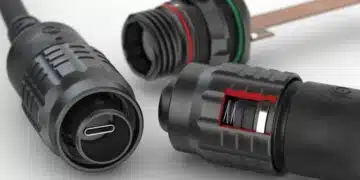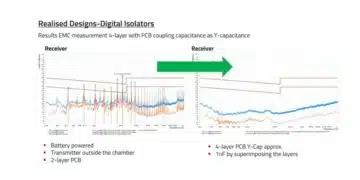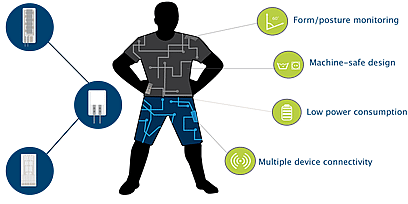source: EDN news
Robert Cox -November 15, 2017. From fitness trackers and smart watches to virtual and augmented reality (VR/AR) headgear, wearable devices now permeate the everyday lives of consumers worldwide. People have come to rely on wearables to monitor their health and well-being, keep them connected to the outside world, and provide endless opportunities for engagement.
Analysts predict that the wearable technology market will reach US$51.60 billion by 2022, driven by these consumer preferences for sophisticated gadgets, the growing incorporation of next-generation displays in wearables, and their intersection with the rapidly rising popularity of the Internet of Things (IoT) and other connected devices.[1]
As enabling technologies in flexible and printed electronics continue to improve, the field of wearable devices is already moving beyond rigid devices to encompass a host of smart textile-based bodywear, neckwear, eyewear, headwear and footwear. This article will focus on the challenges associated with designing smart clothing, and how flexible, printed sensor technology can provide solutions.
What’s Driving the Smart Clothing Market?
Smart clothing is a rapidly emerging market for physical fitness and rehabilitation applications, both at the clinical and personal level. Medical applications are a good starting point for smart clothing, as it has the potential to drive down medical costs and allow clinicians to collect patient data outside of medical facilities. It also helps to more accurately track the patients’ rehabilitation progress; for example, tracking improvements to range of motion or gait over longer periods and in real-world scenarios. However, due to the stricter approval processes, time-to-market in medical applications is likely to be longer than for consumer applications. For that reason, the growth of the industry is expected to be more rapid in the consumer space.
For the sports enthusiast, smart workout gear provides the ability to track one’s own biometrics, including health and fitness indicators such as heart rate, calorie burn, stress level and energy output.[2] For example, fashion clothing designer Ralph Lauren and performance-wear brands like Hexoskin, Athos and Physiclo first demonstrated their smart workout gear at New York Fashion Week in 2015.
For these companies, tracking biometrics is just the start. The next steps will involve integrating technology that stimulates muscles and increases the efficiency of a workout. The idea is that clothing will be regarded not only as tracking devices, but will be considered critical pieces of fitness equipment.[3]
Existing Technology Approaches
Integrating sensors and their companion electronics into smart sports gear has been going on since 2002, when miniaturized electronic devices began replacing the probes, electrodes and masks worn by athletes in training labs.[4] These approaches relied on standard available silicon-based sensors, microcontrollers (MCUs), Bluetooth® transceivers and batteries. Miniaturization was a key focus of these devices, which were sewn into small pockets of fabric as unobtrusively as possible. In some cases, however, these early efforts made clothing cumbersome and uncomfortable, and impeded performance. Additionally, designers were limited in sensor placement, reducing the opportunity for capturing important metrics from multiple data points.
More recently, flexible and printed sensor technologies have been implemented as a solution. Sensoria’s smart socks, for example, use chemically treated textile patches as variable resistors and weave in flexible, silver-based conductive yarn that connects each sock to a magnetic Bluetooth anklet, which then transmits data to a smartphone-based app. These approaches are still rather costly, and highly complex to design. In 2015, two pairs of socks and an anklet retailed for $200.
The Printed Sensing Solution
As printed, flexible sensor technology becomes more advanced and readily available, it is providing a path to solving many design challenges that cannot be addressed by incumbent technologies.
Unlike rigid wearable devices, smart clothing design requires considerable customization. Working with silicon-based technology is a costly and time-consuming endeavor. Delivering a new product can take anywhere from six to nine months, with development costs reaching several million dollars. Alternatively, implementing a new design using printed/flexible electronics can take only a few weeks and cost several thousand dollars. Flexible, printed sensors, therefore, lend themselves perfectly to high-volume manufacturing, thanks to short time-to-market and lower-cost materials.
The flexibility of the sensing device is critical to accurate data acquisition in rehabilitation applications as well as performance training. The sensors must be able to maintain a signal, even when bent at the most extreme angles. This is not possible with rigid silicon-based sensors.
Sensor washability and durability are also important factors in smart-clothing applications. If they can’t be washed, they must be replaceable. As such, new printed sensor solutions must be low-cost and easily replaced.
Power consumption is another design challenge, as wearing a battery adds to the wearer’s discomfort. Printed sensors use less than 1% of the system power budget, with 99.9% attributed to the companion MCUs and wireless devices.
Lastly, data acquisition from the sensor needs to be considered. Rather than just relying on a few data points, printed sensors allow for small-scale arrays located throughout the clothing, to obtain many points of data in a small footprint.
The Science Behind Printed Sensors
Printed sensor technology requires materials science mastery, in addition to development of the electronics. The materials themselves must be sensitive to different stimuli, and the ability to isolate one stimulus from another is essential. Understanding the material science behind the sensors, therefore, is integral to the success of this technology.

The material scientists at Brewer Science have worked in close collaboration with both clothing and electronics systems designers to develop a family of flexible, printed sensors that address the unique challenges of designing smart clothing.
For example, flexible sensors can use materials such as conductive carbon junctions to detect external stimuli while maintaining a thin form factor that is conformable, flexible and durable. Additionally, printed sensors made from these materials exhibit high sensitivity and can be easily made into arrays.
Motion monitoring is another strength of printed sensors. Their flexible form factor enables the measurement of bidirectional bend resistance data with a wide range of motion, ±100 degrees of linearity, and consistent signal amplitude.
Printed moisture sensors, when made with the right materials, can trace moisture variations with an extremely accurate <1% relative-humidity (RH) resolution. Meanwhile, printed temperature sensors can enable clothing with heat-mapping features, due to their extremely fast measurements of the rapid temperature fluctuations that people commonly experience during exercise.
Design Considerations for Printed Sensors
The most difficult aspect of implementing printed sensor technology in smart clothing is the integration of the sensor with nonprinted electronics, such as a microcontroller, Bluetooth device and power source. While these devices may eventually be printed, they don’t lend themselves to the format, and it would require years of costly development.
When implementing printed sensors in a smart-clothing design, fast and accurate analog-to-digital conversion is crucial both for conserving power and obtaining the most useful data. Selecting analog-integrated MCUs or stand-alone analog devices with a low signal-to-noise ratio is another important consideration for ensuring accurate data is being collected.

Dimensions of Brewer Science’s moisture sensor in millimeters
The speed of the sensor’s response to stimulus is also an important issue for controlling power consumption. A traditional silicon-based temperature sensor can take up to five seconds to respond to a change, requiring the MCU to wake up more often for comparative readings. Printed sensors can provide an instant response to temperature changes, allowing greater control of the MCU’s sampling speed, and enabling it to spend more time in a battery-conserving sleep mode.
From the perspective of the clothing designer, one of the main hurdles to overcome in designing smart clothing is the lack of technical knowledge for integrating sensors and electronics. To optimally assist them in achieving their design goals, partners must provide clothing companies with technical know-how that encompasses not only the finished printed sensor and its integration with the system electronics, but also an understanding of the best materials to use in that sensor.
Additionally, it is essential to pair clothing designers with these partners from the earliest concept stages, to ensure design feasibility and allow time for the necessary customization of the printed sensor. This expertise and early collaboration, in combination with the inherently low cost and rapid speed of customizing printed-sensor form factors for volume production, are key to successfully bringing smart clothing to the mass market.
References
- “Wearable Technology Market worth 51.60 Billion USD by 2022,” Markets and Markets Research
- M. Schlossberg, “The next big trend in sportswear isn’t about style at all,” Sept. 11, 2015, BusinessInsider
- L. Dishman, “Here’s why you’ll be wearing ‘smart’ workout clothes soon” Sept. 11, 2015, Fortune
- M. Reisch, “With The Help Of Electronics, Fitness Clothing Is Getting Smarter” Dec. 7, 2015,
- M. Reisch, ibid

































